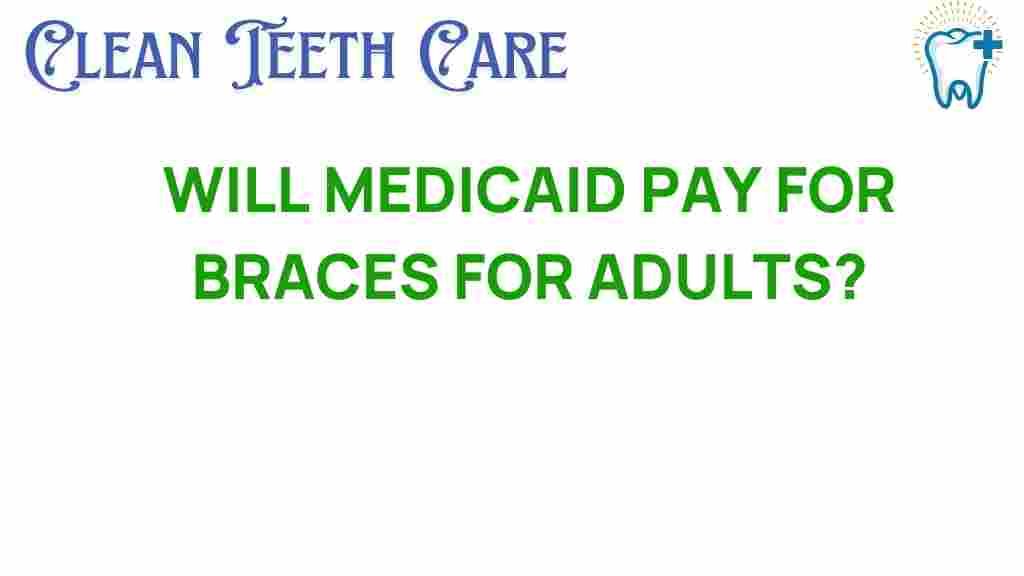Unlocking the Mystery: Will Medicaid Cover Adult Braces?
When it comes to oral health, many adults find themselves contemplating the need for braces to improve their smile and overall dental health. However, a common question arises: Will Medicaid cover adult braces? Understanding the intersection of Medicaid, adult braces, and dental coverage can be complicated, but this guide aims to clarify the details surrounding orthodontics, insurance, and Medicaid benefits for adults seeking dental treatment.
Understanding Medicaid and Its Benefits
Medicaid is a state and federal program that provides health coverage for individuals with low income, including children, pregnant women, and adults. The specific benefits and coverage can vary by state, but generally, Medicaid aims to ensure that essential healthcare services are accessible to those who qualify.
When it comes to dental coverage, Medicaid does provide some level of services, but this can differ significantly depending on where you live. In many states, Medicaid covers necessary dental treatments that are deemed medically necessary, which can sometimes include braces for adults under specific circumstances.
Eligibility Criteria for Medicaid Coverage of Adult Braces
To determine if your adult braces might be covered under Medicaid, consider the following eligibility criteria:
- Income Level: Applicants must meet income requirements set by their state.
- Medically Necessary Treatment: Braces must be considered medically necessary, which can include severe misalignment that affects chewing or contributes to further dental issues.
- Age: While most states cover braces for children, coverage for adults is more limited and may require specific documentation from a dentist or orthodontist.
Step-by-Step Process to Obtain Medicaid Coverage for Adult Braces
Here’s a step-by-step guide on how to navigate the process of obtaining Medicaid coverage for adult braces:
Step 1: Check Your State’s Medicaid Program
Start by visiting your state’s Medicaid website. Each state has its own rules regarding dental coverage and what is considered a medically necessary treatment. It’s crucial to familiarize yourself with these guidelines.
Step 2: Schedule a Dental Evaluation
Book an appointment with a dentist who accepts Medicaid. This initial evaluation will help determine if braces are required for your oral health. The dentist can assess your condition and provide documentation that supports your need for orthodontic treatment.
Step 3: Obtain a Referral to an Orthodontist
If your dentist determines that braces are necessary, they may refer you to an orthodontist. This specialist will further evaluate your dental needs and determine the best treatment plan.
Step 4: Prepare Documentation
Gather all necessary documentation, including:
- Dental evaluations and x-rays
- Referrals from your dentist
- Proof of your Medicaid eligibility
Step 5: Submit a Prior Authorization Request
Your orthodontist may need to submit a prior authorization request to Medicaid, detailing the necessity of braces based on your dental evaluations. This step is critical as it will determine if your treatment will be covered.
Step 6: Await Approval
After you’ve submitted the required documents, it may take some time for Medicaid to review and approve your request. Be patient, and consider following up with your orthodontist to check on the status of the approval.
What If Your Medicaid Claim Is Denied?
If your request for dental treatment coverage is denied, don’t lose hope. Here are some troubleshooting tips:
- Understand the Reason: Review the denial letter from Medicaid to understand why your claim was denied.
- Gather More Evidence: Sometimes, additional documentation or a more detailed explanation from your dentist or orthodontist can help.
- Appeal the Decision: Most states allow you to appeal a Medicaid denial. Follow the appeal process outlined in your denial letter.
- Seek Alternative Financial Assistance: If Medicaid does not cover your braces, look into other financial assistance programs or dental schools that may offer discounted services.
The Importance of Oral Health
Maintaining good oral health is essential for overall well-being. Misaligned teeth can lead to various issues, including:
- Difficulty in chewing and speaking
- Increased risk of tooth decay and gum disease
- Jaw pain or temporomandibular joint (TMJ) disorders
Investing in braces, when necessary, can greatly improve your quality of life and oral health. If you are considering braces, it’s important to explore all available options, including Medicaid benefits.
Conclusion
In conclusion, while Medicaid coverage for adult braces is not universally guaranteed, it is possible to obtain coverage if you meet specific criteria and can demonstrate that the treatment is medically necessary. By understanding the process and actively engaging with your dental care providers, you can unlock the mystery of Medicaid and its role in your orthodontic needs.
For more information on financial assistance for dental treatments, consider visiting this resource. It is crucial to stay informed and proactive about your oral health and available insurance options.
Remember, having a healthy smile is an invaluable asset, and with the right support, you can take the necessary steps to achieve it.
This article is in the category Treatments and created by CleanTeethCare Team
